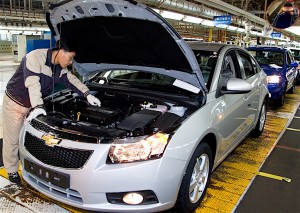Union workers at General Motors’ money-losing South Korean operations have barely three weeks to come up with a package of concessions or the automaker says it will plunge the entire unit into bankruptcy, a move that could lead to its pulling out of the market.
The announcement by GM follows its decision in February to close one of its four assembly plants in the country and examine whether it could keep the other facilities open. Along with the union concessions, GM is demanding new support from the South Korean government.
The Detroit automaker is “using threats to ramp up pressure on the union to make concessions,” a government official told Reuters. The news service also cited a document indicating GM is trying to lock down $600 million in operating funds by the end of April to keep the South Korean operations going.
A GM spokesman confirmed that without a new business plan locked down by April 20 the automaker would have no option but to file for bankruptcy.
(GM’s proposed $2.8 billion investment could head off showdown or shutdown in South Korea. Click Here for the story.)
The decision to close the Gunsan plant, located about 120 miles from the South Korean capital of Seoul, will result in an $850 million charge, GM said last month, including $375 million in termination benefits for its 2,000 employees. The factory operated at barely 20% of its capacity last year, building both the Chevrolet Cruze sedan and the Orlando SUV.
Meanwhile, about 2,500 of the carmaker’s Korean workers, about 15% of the total workforce, have applied for a redundancy package as a result of the planned changes. All told, GM Korea has indicated it wants to cut 5,000 jobs to become more efficient without reducing total vehicle production.
GM has had a tempestuous relationship with the Korean auto industry since first entering the market three decades ago. It initially formed a joint venture with the domestic manufacturer Daewoo, breaking it off due to deep divides between the management of the two companies. But when Daewoo went bankrupt during a severe Asian economic crisis General Motors moved in to buy its assets, eventually renaming the subsidiary GM Korea.
(Click Here for details about GM shutting one Korean plant, considering fate of others.)
GM saw the acquisition as an opportunity to produce both for the booming Korean domestic market while also exporting vehicles to the U.S. and other markets with high labor costs. Last year, the company sold 132,377 vehicles in Korea and exported another 392,170 cars and crossovers to 120 other countries.
But aggressive labor unions, combined with weak local sales and other factors have forced GM to rethink that strategy. From 2014 through 2016, the maker has run up $1.8 billion in net losses in Korea.
Barry Engle, president of GM International, has made repeated visits to Korea in recent weeks, hoping to win over not only union officials and government leaders but also to gain support from the Korean Development Bank, the second-largest shareholder in GM Korea. The KDB is now studying whether it will make new funding available to the operation.
(GM sales surge in China, even as Ford’s fall. Click Here for the latest.)
The threat of a Korean market pullout might have seemed unlikely until recently. But GM CEO Mary Barra has, since being named to the role four years ago, shown a willingness to abandon money-losing operations. That includes South Africa, Venezuela and India, and even Europe where the U.S. automaker sold its deep-in-the-red Opel/Vauxhall operations last year to Peugeot parent PSA.



Look Mary, if you can’t make it in Korea, just leave. Save the drama for when you want another government bailout.
Another US taxpayer bailout. And GM will get it too.
No U.S. tax dollars involved.
Paul E.